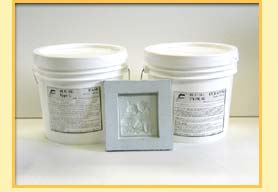Blu-Sil

BLU-SIL CMC is a 2 component system consisting of a white fluid base “A” and a blue fluid catalyst “B”, designed to be mixed at the time of use, into a fluid which will set into a flexible rubbery solid at room temperature or at very slightly elevated temperatures. the catalyst is colored to permit ease in determining completeness of mix, by uniformity of color in the mixed compound. BLU-SIL sets uniformly throughout the mass regardless of the thickness of the material, and the set is independent of external moisture or other factors except elevated temperatures.
USES
Practically all castable synthetic resins, plaster, cements, and waxes release readily from cured BLU-SIL molds without partings. They are especially adaptable most epoxy resins and of acrylic compounds that are formed cold, and later cure at more or less elevated temperatures. Parting compounds are generally unnecessary where continuous castings are made. Those plastics which contain penetrating monomers, such as polyester (styrene) and methyl methacrylate will be slowly absorbed and may shorten the useful life of the mold. For longest service, a thin film of Ease Release 200 is recommended.
Soft, tender plasters of the investment or “metal casting” type release readily without fracture, or break-off of undercuts and back drafts. BLU-SIL maintains relatively uniform softness and flexibility from temperatures below 0 deg. F. to near 400 deg.F. It is therefore useful over the whole range of ordinarily encountered casting temperatures.
MODEL PREPARATION
Wherever possible, the pattern should be non-porous to permit ready release. Dry plaster, paper, wood, etc., may be given a very thin coat (8 oz. cut) of shellac, followed by a film of PERMA-FLEX Parting, soap type, is sufficient on most plaster surfaces, where plaster is damp or wet. Wax type modeling clays must be shellacked. (Plastilene and wax type modeling clays may interfere with surface cure, see above.)
BLU-SIL parts from most non-porous surfaces except glass without the need for a parting agent. A thin film of Perma-Flex Polyurethane Parting Compound is suggested for this purpose. Wherever there is doubt of easy parting give pattern a thin coat of orange shellac. When many molds of pours of BLU-SIL are made over the same pattern, (metal, wood, etc.) there is a possibility of the BLU-SIL sticking to the pattern. Also to the mixing container if glass or enamel. We advise that the pattern be given a thin coat of orange shellac to assure easy removal of the cured BLU-SIL, with out tearing or surface damage from sticking.
MOLDMAKING
Refer to the various procedures followed in PERMA-FLEX’s literature covering PERMA-FLEX CMC. In general, BLU-SIL does not have the elongation of “stretch” of the polysulfide CMC’s such as Blak-Tufy, etc., since by its nature it is low in elongation and tensile strength. When it is necessary to part BLU-SIL from BLU-SIL, apply a thin coat of Perma-Flex Polyurethane Parting Compound.
REPAIR
When used under severe conditions, BLU-SIL is subject fracture, but may be repaired by applying a thin film of fresh mix to the broken areas and pressing them together lightly overnight, or for a few hours under light heating at about 150 deg. F.
MIXING
Weight the required amount of BLU-SIL “A” on accurate equipment into a clean suitable mixing vessel. Add catalyst “B” at the rate of 5 parts “B” per 2 parts “A” by weight; *and mix thoroughly until catalyst color has been thoroughly dispersed, by hand or machine. Continue mixing for 1 or 2 minutes after uniform color develops. Allow mix to stand for a few minutes to vent large entrapped air bubbles Pour in the thinnest possible stream into the previously prepared mold assembly, preferably allowing the pour to flow up from the bottom, or across critical surfaces to permit proper fill. Where very detailed surfaces are being molded, use a soft brush to fill in backdraft and get perfect contact between pattern surface and the BLU-SIL mix. Allow the poured mix to set undisturbed until the back has become “tack”- free, usually overnight, then strip carefully from the pattern. Freshly set BLU-SIL is somewhat tender and must be handled accordingly. It is good practice to develop a supporting backing in ULTRACAL whenever a free floating or open back mold is poured; otherwise, casts may be distorted by the flexibility of the mold itself. (All flexible molds require support of non-expanding rigid back-ups for maximum fidelity of dimension).
*NOTE - Volume proportioning is not recommended.
STORAGE
BLU-SIL CMC will remain reasonably uniform in viscosity at room temperature for 6 months in normal room temperature storage. Wherever storage life maybe longer, refrigeration at below 50 deg. F. is recommended. Containers of Base and Catalyst should be closed securely.
Both components of BLU-SIL MUST be thoroughly stirred before every time of use as accumulative settling of the component pigments will cause thickening of the BLU-SIL when volume in container becomes less.



